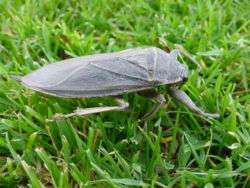Belostomatidae
| Belostomatidae | |
|---|---|
 | |
| Lethocerus americanus in Montana, USA | |
| Scientific classification | |
| Kingdom: | Animalia |
| Phylum: | Arthropoda |
| Class: | Insecta |
| Order: | Hemiptera |
| Infraorder: | Nepomorpha |
| Family: | Belostomatidae Leach, 1815 |
| Subfamilies and genera | |
|
Belostomatinae Lethocerinae
| |
Belostomatidae is a family of freshwater hemipteran insects known as giant water bugs or colloquially as toe-biters, Indian toe-biters, electric-light bugs, alligator ticks, or alligator fleas (in Florida). They are the largest insects in the order Hemiptera, and occur worldwide, with most of the species in North America, South America, Northern Australia, and East Asia. They are typically encountered in freshwater streams and ponds. Most species are relatively large, typically at least 0.75 in (2 cm) long, although smaller species also exist. The largest are members of the genus Lethocerus, which can exceed 4.75 in (12 cm) and nearly reach the length of some of the larger beetles in the world. Giant water bugs are a popular food in parts of southeast Asia.
Habits

Feeding and defense
Belostomids are aggressive predators which stalk, capture, and feed on aquatic invertebrates, snails, crustaceans, fish, and amphibians. The largest species have also been found to capture and feed on baby turtles and water snakes.[1] They often lie motionless at the bottom of a body of water, attached to various objects, where they wait for prey to come near. They then strike, injecting a powerful digestive saliva with their rostrum, and sucking out the liquefied remains. Their bite is considered one of the most painful that can be inflicted by any insect; however, though excruciatingly painful, it is of no medical significance. Adults cannot breathe under water, so must surface periodically for air.[2] Occasionally, when encountered by a larger predator, such as a human, they have been known to "play dead" and emit a fluid from their anus.[2] Due to this, they are assumed dead by humans only to later "come alive" with painful results.[2]
Breeding

Belostomatids show paternal care and these aspects have been studied extensively, among others involving the North American Belostoma flumineum and the East Asian Lethocerus (Kirkaldyia) deyrollei. In species of the subfamily Belostomatinae, the eggs are typically laid on the male's wings and carried until they hatch. The male cannot mate during this period. The males invest considerable time and energy in reproduction and females take the role of actively finding males to mate. This role reversal matches the predictions of R. L. Trivers' parental investment theory. In the subfamily Lethocerinae, the eggs are laid on emergent vegetation and guarded by the male.
In Asian cuisine

In some areas, belostomatids are considered a delicacy, and can be found for sale in markets. This is mainly in Southeast Asia involving the species Lethocerus indicus. They are often collected for this purpose using large floating traps on ponds, set with black lights to attract the bugs. Adults fly at night, like many aquatic insects, and are attracted to lights during the breeding season.
References
- ↑ "BBC Nature - Giant water bug photographed devouring baby turtle". BBC Nature.
- 1 2 3 A. C. Huntley (1998). "Lethocerus americanus, the "toe biter"". Dermatology Online Journal. 4 (2): 6.
Further reading
- P. J. Perez-Goodwyn (2006). "Taxonomic revision of the subfamily Lethocerinae Lauck & Menke (Heteroptera: Belostomatidae)". Stuttgarter Beiträge zur Naturkunde, Serie A (Biologie). 695: 1–71.
- D. R. Lauck (1962). "A monograph of the genus Belostoma (Hemiptera), Part I. Introduction and B. Dentatum and Subspinosum groups". Bulletin of the Chicago Academy of Sciences. 11 (3): 34–81.
- D. R. Lauck (1963). "A monograph of the genus Belostoma (Hemiptera), Part II. B. Aurivillianum, Testaceopallidium, Dilatatum, and Discretum groups". Bulletin of the Chicago Academy of Sciences. 11 (4): 82–101.
- D. R. Lauck (1964). "A monograph of the genus Belostoma (Hemiptera, Part III. B. Triangulum, Bergi, Minor, Bifoveolatum, and Flumineum groups". Bulletin of the Chicago Academy of Sciences. 11 (5): 102–154.
- A. S. Menke (1960). "A taxonomic study of the genus Abedus Stål (Hemiptera, Belostomatidae)". University of California Publications in Entomology. 16 (8): 393–440.
- R. L. Smith (1974). "Life history of Abedus herberti in Central Arizona" (PDF). Psyche. 81 (2): 272–283. doi:10.1155/1974/83959.
- R. T. Schuh & J. A. Slater (1995). "True Bugs of the World (Hemiptera:Heteroptera): Classification and Natural History". Cornell University Press.
External links
| Wikimedia Commons has media related to Belostomatidae. |
| Wikispecies has information related to: Belostomatidae |
- Factsheet from zoo.org
- Sex role reversal
- Toebiters
- Pictures of a Giant Water bug from whatsthatbug.com
- Lethocerus, Abedus, Belostoma spp. on the University of Florida / Institute of Food and Agricultural Sciences Featured Creatures Web site
- Giant Water Bug Feeding on Frog